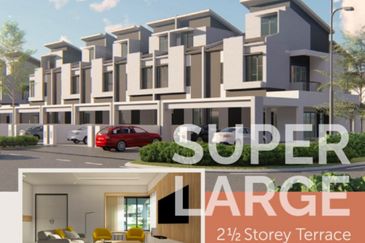
- The Sarawak Land Code is a vital tool in managing land in Sarawak, balancing the demands of development with the preservation of indigenous rights.
The Sarawak Land Code is a comprehensive legislative framework that governs land administration and management in the state of Sarawak. First enacted in 1958 during the Brooke administration, the Land Code plays a crucial role in balancing development, customary land rights and sustainable land use. Given the unique history and cultural diversity of Sarawak, the code also seeks to protect the land rights of indigenous communities, known as Natives, while facilitating economic growth and land utilisation for commercial purposes.
In this article, we will explore the key features of the Sarawak Land Code, its importance and its implications for both local communities and investors.
Whether you’re a property owner, investor, or an indigenous community member, understanding this Land Code is essential for navigating the complexities of land matters in Sarawak.
Key land classifications
Sarawak’s land is divided into various categories, each subject to specific rules and restrictions:
- Native Customary Rights (NCR) Land: Refers to land traditionally occupied or cultivated by indigenous communities based on their customs. While it may not be formally titled, NCR land enjoys government recognition. Efforts have been made to survey and register such lands, but challenges around boundaries and recognition persist.
- State Land: Land owned by the Sarawak state government, which can be leased or granted to individuals or businesses for various purposes, including agriculture and development. Terms for these leases or grants are dictated by government regulations.
- Mixed Zone Land (MZL): This classification allows both natives and non-natives to own and transfer land, making it suitable for residential and commercial development. It’s a key area of interest for investors.
- Native Area Land (NAL): Specifically reserved for Sarawak natives, this land can only be owned by them. Sale or transfer of ownership to non-natives is either restricted or prohibited altogether.
Native customary rights (NCR)
One of the most crucial elements of the Sarawak Land Code is the recognition of NCR. These rights relate to land that has been used or cultivated by indigenous communities for generations, often without formal titles. NCR land is governed by customary laws, and its ownership and boundaries are based on traditional practices. These lands are primarily used for agriculture, hunting and habitation by indigenous groups such as the Iban, Bidayuh and Orang Ulu communities.
Over the years, development projects — such as plantations, logging, and infrastructure projects — have complicated the recognition of NCR lands. In response, the Sarawak government has initiated programmes to survey and map these lands to provide formal recognition. Despite this, issues related to boundary disputes and the protection of indigenous rights remain contentious.
Land acquisition and compensation
Under the Sarawak Land Code, the state has the power to acquire land for public purposes such as infrastructure development, economic projects, or resource extraction. However, the code ensures that landowners, including those with NCR land, receive fair compensation based on market value. Compensation also includes losses due to the acquisition, such as damage to crops or property and other factors like relocation costs or loss of income.
The state can justify land acquisition for large-scale projects that are deemed beneficial to the public, such as road construction, energy projects or industrial estates. While this encourages growth, it sometimes leads to disputes with local communities whose land may be affected.
In the case of NCR land, compensating landowners can be more complex. Since much of this land isn’t formally titled, determining its value is more subjective, often leading to legal disputes between landowners and the state.
Resolving land disputes
Land disputes, particularly regarding NCR land, are a common challenge in Sarawak. The Sarawak Land Code sets out legal mechanisms for resolving these conflicts. Courts play a significant role in adjudicating land claims and compensation disputes, but legal battles over NCR land are often lengthy and complicated.
To mitigate the burden on the courts, alternative dispute resolution mechanisms, such as mediation, have been introduced in recent years. This offers landowners a quicker and less costly way to settle disputes without the need for formal litigation.
Recent reforms and amendments
One of the most significant amendments to the Sarawak Land Code came with the Sarawak Land Code (Amendment) Bill 2018. The amendment introduced provisions for the establishment of Native Communal Reserves, which addressed the recognition of pemakai menoa (territorial domain) and pulau galau (communal forest reserve). These terms refer to traditional areas used by indigenous communities for hunting, gathering and other communal activities.
The 2018 reforms aimed to formalise the recognition of these lands, allowing indigenous communities to claim them through legal channels. As Sarawak continues to experience rapid economic development — especially in agriculture, energy and tourism — further reforms to the Land Code may be required. Policymakers are faced with the challenge of facilitating growth while ensuring that native communities retain their land rights and are fairly compensated when their land is needed for public projects.
Ongoing challenges and the future
As Sarawak continues to develop, balancing the need for land development with the rights of indigenous communities is an ongoing challenge. The Sarawak Land Code, while critical in regulating land use, faces several key issues:
- Land development vs indigenous rights: Large-scale developments — such as oil palm plantations, hydroelectric dams and logging activities — frequently clash with indigenous claims over NCR land. Communities often express concerns that their land is encroached upon without adequate consultation or compensation.
- Surveying and titling of NCR land: Efforts to formalise NCR land through surveys and titling have been slow and fraught with disputes. Many indigenous landholders argue that the state’s surveying efforts do not reflect the full extent of their traditional territories, leading to legal challenges.
- Environmental considerations: Sarawak is home to significant biodiversity, making land use a sensitive issue. Deforestation and land clearing for agriculture threaten not only the environment but also the livelihoods of indigenous people who rely on these lands for sustenance and cultural practices.
Land registration, titles, and transfer procedures
To formalise land ownership in Sarawak, the Land Code mandates a system of land registration. Every piece of land must be recorded with a title, and all transfers of ownership must follow specific legal protocols.
- Types of land titles: Sarawak issues various types of land titles, including perpetual leases, temporary leases and outright grants of land. The length of ownership and restrictions on land use depend on the type of title issued.
- Land transfer restrictions: While land transfer is generally allowed, there are certain restrictions, especially concerning Native Area Land, which is protected from speculative purchases by non-natives. Any transfer of such land to non-natives requires special government approval, a process designed to safeguard native ownership.
- Registration process: All transactions involving land — whether sales, leases or transfers — must be registered with Sarawak’s Land and Survey Department. This ensures that ownership is legally recognised and documented, reducing the risk of disputes.
Conclusion
The Sarawak Land Code is a vital tool in managing land in Sarawak, balancing the demands of development with the preservation of indigenous rights. However, it remains a complex and evolving legal framework. With ongoing reforms and increasing attention to environmental sustainability and indigenous rights, the future of land management in Sarawak will likely require further legal adjustments and more inclusive processes.
For property owners, developers, and indigenous communities alike, a deep understanding of the Sarawak Land Code is crucial. As Sarawak continues to grow, the way land is managed will play a key role in shaping the future of land use in the region while protecting its rich cultural heritage and ensuring a fair and sustainable future for all stakeholders.
Looking to buy a home? Sign up for EdgeProp START and get exclusive rewards and vouchers for ANY home purchase in Malaysia (primary or subsale)!
TOP PICKS BY EDGEPROP

Amber Residence @ twentyfive.7
Kota Kemuning, Selangor

Taman Bukit Senawang Perdana
Seremban, Negeri Sembilan

Taman Sunggala Hartamas
Port Dickson, Negeri Sembilan






















